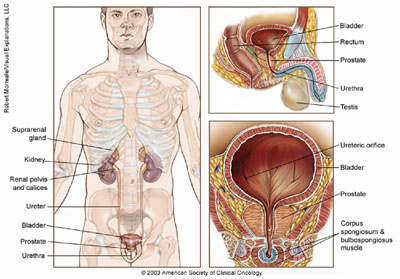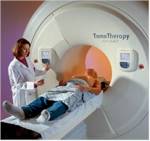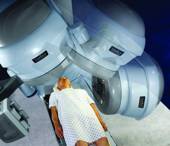
After a diagnosis of prostate cancer has been established with a biopsy, the patient should discuss the treatment options with a radiation oncologist and a urologist.
Radiation therapy treatment options to cure prostate cancer include:
- External beam radiotherapy
- Prostate brachytherapy

- External beam radiotherapy involves a series of daily outpatient treatments to accurately deliver radiation to the prostate.
- Image Guided Intensity Modulated Radiation Therapy (IG IMRT) is the most recent advance in the delivery of radiation. This technique allows very precise adjustment of radiation doses to the tissues within the target area, potentially allowing an increased radiation dose to the prostate and reduced dose to nearby normal tissues such as rectum and bladder. Higher doses to the prostate translate into a greater chance for cure, while lower doses to surrounding organs mean fewer side effects. Daily imaging is obtained before your treatment to optimize precise delivery of radiation.
- IMRT radiation treatments are delivered in a series of daily sessions, each under half-hour in duration, Monday through Friday for seven to ten weeks overall.
At both St. Agnes Cancer Center and GBMC -- CT technology is utilized for the most precise targeting available.


Potential side effects, including fatigue, increased frequency or discomfort of urination, and proctitis, typically resolve within a few weeks after completing treatments. Impotence is also a potential late side effect of any treatment for prostate cancer. However, many patients who receive radiation therapy for prostate cancer are able to maintain sexual function.
Prostate Brachytherapy
Prostate brachytherapy, better known as a seed implant, is a short surgical procedure typically done done in the operating room.
There are two methods of delivering internal radiation for prostate cancer:
- Permanent seed implants.
These treatments are designed to deliver a very high dose of radiation to the tumor by inserting radioactive seeds directly into the prostate gland under ultrasound guidance while the patient is under anesthesia. Isotopes of iodine or palladium are most commonly used. The seeds are approximately four millimeters long and less than a millimeter in diameter. In certain situations, both prostate brachytherapy and external radiation may be recommended to combat the tumor.



- High-dose rate temporary implants.
A device called high dose rate remote afterloading machine allows radiation oncologists to complete brachytherapy over 10 to 20 minutes in 2 or 3 sessions. Powerful radioactive sources travel through small tubes called catheters to the prostate gland for the amount of time prescribed by your radiation oncologist. You may be able to go home shortly after the procedure. No seed remains in the patient after the treatment is completed.
The side effects from seed implants are similar to those experienced with external beam radiotherapy. Patients usually experience urinary frequency and discomfort in urination. These effects may be lessened with medications and usually dissipate over the course of three to six months.
Hormone Therapy
Certain patients may benefit from hormone therapy in addition to radiation. In some patients, hormone therapy works with radiation therapy to improve cure rates.

